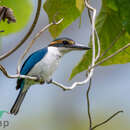ar
الأسماء في صفحات التنقل


The Pacific kingfisher (Todiramphus sacer) is a medium-sized kingfisher belonging to the subfamily Halcyoninae, the tree kingfishers. It has a wide range throughout the South Pacific islands. It was previously considered a subspecies of the collared kingfisher.
The Pacific kingfisher was formally described in 1788 by the German naturalist Johann Friedrich Gmelin in his revised and expanded edition of Carl Linnaeus's Systema Naturae. He placed it with the other kingfishers in the genus Alcedo and coined the binomial name Alcedo sacra.[1] Gmelin based his description on the "sacred kingfisher" that had been described and illustrated in 1782 by the English ornithologist John Latham in his multi-volume A General Synopsis of Birds. Latham noted that the Polynesians revered and protected kingfishers. Latham had access to a specimen in the Leverian Museum in London that had been collected during James Cook's third voyage to the Pacific Ocean from 1776 to 1780.[2][3] The type locality was designated as the island of Tongatabu by Alexander Wetmore in 1919.[4][5] The Pacific kingfisher is now one of 30 species placed in the genus Todiramphus that was introduced in 1827 by René Lesson.[6][7] The word Todiramphus combines the genus name Todus with the Ancient Greek rhamphos meaning "bill". The specific epithet sacer is Latin meaning "sacred".[8]
The Pacific kingfisher was formerly considered as a subspecies of the collared kingfisher (Todiramphus chloris). A molecular phylogenetic study published in 2015 found that T. chloris was paraphyletic.[9] In the changes to create monophyletic species, T. sacer was promoted to species status and many of the T. chloris subspecies were moved to T. sacer.[7]
There are 22 recognised subspecies:[7]
It has a variety of calls which vary geographically. The most typical call is loud, harsh and metallic and is repeated several times.
It is most commonly found in coastal areas, particularly in mangrove swamps. It also inhabits farmland, open woodland, grassland and gardens. It is usually seen further inland than the collared kingfisher, where it was previously considered conspecific, ranging into forest or into mountain areas. Birds often perch conspicuously on wires, rocks or bare branches.
On the Pacific islands it is usually common in a variety of coastal and inland habitats with various subspecies present on the Solomon Islands, Vanuatu, Fiji, Tonga, and American Samoa.
Small crabs are the favoured food in coastal regions but a wide variety of other animals are eaten including insects, worms, snails, shrimps, frogs, lizards, small fish and sometimes other small birds as well. The bird perches almost motionless for long periods waiting for prey. When it spots something it glides down to catch it and then flies back to the perch where larger items are pounded against the branch to subdue them. Any indigestible remains are regurgitated as pellets.
The nest is a hole, either a natural tree hole or a burrow excavated by the birds themselves in a rotten tree, termite mound or earth bank. They will also occupy old woodpecker holes. Two to seven rounded whitish eggs are laid directly on the floor of the burrow with no nest material used. Both parents take part in incubating the eggs and feeding the chicks. The young birds leave the nest about 44 days after hatching. Two broods are often raised in a year.
The Pacific kingfisher (Todiramphus sacer) is a medium-sized kingfisher belonging to the subfamily Halcyoninae, the tree kingfishers. It has a wide range throughout the South Pacific islands. It was previously considered a subspecies of the collared kingfisher.
De pacifische ijsvogel (Todiramphus sacer) is een vogel uit de familie Alcedinidae (ijsvogels). Deze soort wordt vaak nog beschouwd, onder andere door BirdLife International, als ondersoort van de witkraagijsvogel (T. chloris) en is daarom niet als soort geëvalueerd voor een IUCN-status.
De pacifische ijsvogel (Todiramphus sacer) is een vogel uit de familie Alcedinidae (ijsvogels). Deze soort wordt vaak nog beschouwd, onder andere door BirdLife International, als ondersoort van de witkraagijsvogel (T. chloris) en is daarom niet als soort geëvalueerd voor een IUCN-status.
Stillahavskungsfiskare[1] (Todiramphus sacer) är en fågel i familjen kungsfiskare inom ordningen praktfåglar.[2] Tidigare betraktades den som en underart till halsbandskungsfiskare (T. chloris). IUCN gör det fortfarande, varför den inte placeras i någon hotkategori.
Stillahavskungsfiskare förekommer på öar i sydvästra Stilla havet och delas in i hela 22 underarter med följande utbredning:[2]
Underartsgruppen vitiensis fördes tidigare till helig kungsfiskare (T. sanctus).
Stillahavskungsfiskare (Todiramphus sacer) är en fågel i familjen kungsfiskare inom ordningen praktfåglar. Tidigare betraktades den som en underart till halsbandskungsfiskare (T. chloris). IUCN gör det fortfarande, varför den inte placeras i någon hotkategori.
Stillahavskungsfiskare förekommer på öar i sydvästra Stilla havet och delas in i hela 22 underarter med följande utbredning:
juliae-gruppen T. s. torresianus – Torresöarna (Toga, Loh och Hiu) T. s. santoensis – Banksöarna till Espíritu Santo och Malo (norra Vanuatu) T. s. juliae – norra och centrala Vanuatu (öarna Maewo och Aoba till Efate) T. s. erromangae – Erromango (södra Vanuatu) T. s. tannensis – Tanna (södra Vanuatu) sacer-gruppen T. s. sacer – Tonga T. s. pealei – Tutuilaöarna (Amerikanska Samoa) T. s. manuae – Ofu, Olosega och Tau (Amerikanska Samoa) solomonis-gruppen T. s. pavuvu – Pavuvu (Russelöarna i centrala Salomonöarna) T. s. mala – Malaita (östra Salomonöarna) T. s. amoenus – Rennell och Bellona i Salomonöarna T. s. sororom – Malaupaina och Malaulalo (södra Salomonöarna) T. s. solomonis – Uki Ni Masi, Makira och Santa Anna i Salomonöarna T. s. brachyurus – Revöarna (Fenualoa och Lomlon) T. s. vicina – Dufföarna (östra Salomonöarna) T. s. ornatus – Santa Cruzöarna och Tinakula (östra Salomonöarna) T. s. utupuae – Utupua (Santa Cruzöarna i östra Salomonöarna) T. s. melanodera – Vanikoro (Santa Cruzöarna i östra Salomonöarna) vitiensis-gruppen T. s. vitiensis – Fiji (Vanua Levu, Taveuni, Viti Levu, Ovalau, Koro och Gau) T. s. eximius – Fiji (Kadavu, Ono och Vanua Kula) T. s. regina – Futuna (Wallis- och Futunaöarna i centrala Polynesien T. s. marinus – Lauöarna i östra FijiUnderartsgruppen vitiensis fördes tidigare till helig kungsfiskare (T. sanctus).